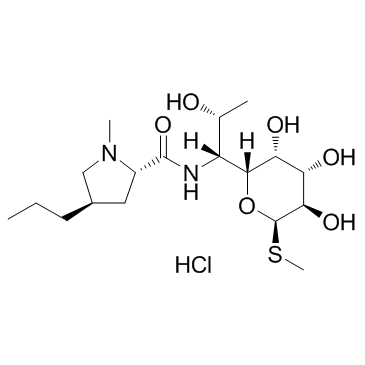Lincomycin hydrochloride

Lincomycin hydrochloride structure
|
Common Name | Lincomycin hydrochloride | ||
|---|---|---|---|---|
| CAS Number | 859-18-7 | Molecular Weight | 442.998 | |
| Density | N/A | Boiling Point | 646.8ºC at 760 mmHg | |
| Molecular Formula | C18H35ClN2O6S | Melting Point | 156-158ºC | |
| MSDS | Chinese USA | Flash Point | 345ºC | |
| Symbol |

GHS07 |
Signal Word | Warning | |
|
Performance characterization of a quantitative liquid chromatography-tandem mass spectrometric method for 12 macrolide and lincosamide antibiotics in salmon, shrimp and tilapia.
J. Chromatogr. B. Analyt. Technol. Biomed. Life Sci. 967 , 203-10, (2014) This paper describes an extension and performance characterization of a quantitative confirmatory multi-residue liquid chromatography-tandem mass spectrometric method for residues of macrolide and lincosamide antibiotics, originally validated for application ... |
|
|
Gene expression of ribosomal protein mRNA inChironomus riparius: Effects of endocrine disruptor chemicals and antibiotics
Comp. Biochem. Physiol. C. Toxicol. Pharmacol. 156(2) , 113-20, (2012) Ribosomal protein genes are essential for cellular development. To examine the effects of ribosomal protein genes under various cellular stress conditions in chironomids, ribosomal protein S3 (RpS3) and S6 (RpS6) cDNA from Chironomus riparius were characteriz... |
|
|
Low-oxygen-recovery assay for high-throughput screening of compounds against nonreplicating Mycobacterium tuberculosis.
Antimicrob. Agents Chemother. 51 , 1380-5, (2007) Screening for new antimicrobial agents is routinely conducted only against actively replicating bacteria. However, it is now widely accepted that a physiological state of nonreplicating persistence (NRP) is responsible for antimicrobial tolerance in many bact... |
|
|
Uptake and effects of a mixture of widely used therapeutic drugs in Eruca sativa L. and Zea mays L. plants.
Ecotoxicol. Environ. Saf. 108 , 52-7, (2014) Pharmaceutically active compounds (PACs) are continuously dispersed into the environment due to human and veterinary use, giving rise to their potential accumulation in edible plants. In this study, Eruca sativa L. and Zea mays L. were selected to determine t... |
|
|
Iron is involved in the maintenance of circadian period length in Arabidopsis.
Plant Physiol. 161(3) , 1409-20, (2013) The homeostasis of iron (Fe) in plants is strictly regulated to maintain an optimal level for plant growth and development but not cause oxidative stress. About 30% of arable land is considered Fe deficient because of calcareous soil that renders Fe unavailab... |
|
|
Identification of Novel Components Influencing Colonization Factor Antigen I Expression in Enterotoxigenic Escherichia coli.
PLoS ONE 10 , e0141469, (2015) Colonization factors (CFs) mediate early adhesion of Enterotoxigenic Escherichia coli (ETEC) in the small intestine. Environmental signals including bile, glucose, and contact with epithelial cells have previously been shown to modulate CF expression in a str... |
|
|
[Functional state of the ileum, cationic peptids and zinc content in the Paneth cells of the rats following lincomycin, indomethacin and methotrexate andministration].
Fiziol. Zh. 59(3) , 78-88, (2013) In the paper the relation between the changes of a functional condition of ileum, composition of its microflora and secretory activity of Paneth cells has been investigated. Administration of lincomycin led to a reduction of total of symbiotic bacteria and ap... |
|
|
Comparison of an Enzyme-Linked Immunosorbent Assay with an Immunochromatographic Assay for Detection of Lincomycin in Milk and Honey.
Immunol. Invest. 44 , 438-50, (2015) An enzyme-linked immunosorbent assay (ELISA) and an immunochromatographic assay were constructed for the detection of lincomycin (LIN) in both milk and honey samples based on the monoclonal antibody named 5F6. The half-maximum inhibition of ELISA was 0.3 ng/m... |
|
|
Biochemistry: Elusive source of sulfur unravelled.
Nature 518(7537) , 45-6, (2015)
|
|
|
Metabolic coupling of two small-molecule thiols programs the biosynthesis of lincomycin A.
Nature 518(7537) , 115-9, (2015) Low-molecular-mass thiols in organisms are well known for their redox-relevant role in protection against various endogenous and exogenous stresses. In eukaryotes and Gram-negative bacteria, the primary thiol is glutathione (GSH), a cysteinyl-containing tripe... |